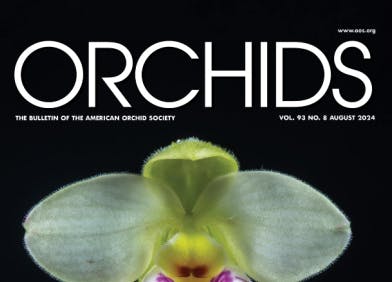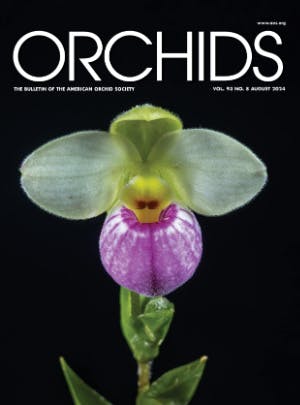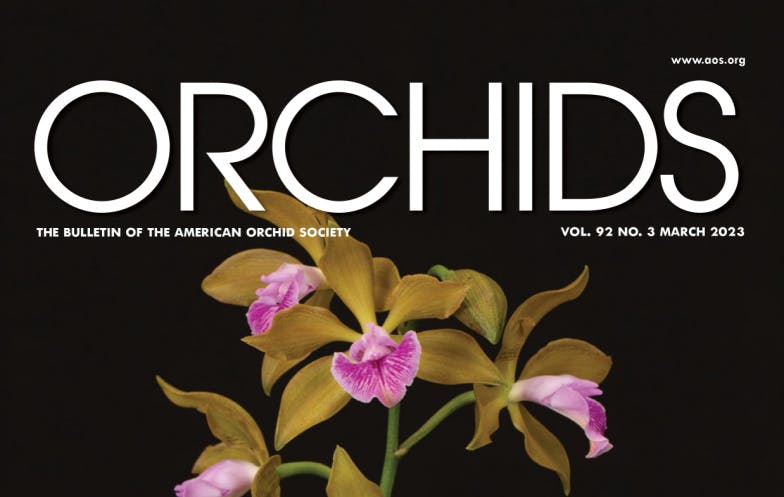
Orchids have flowers for one reason, for sexual reproduction, so the flower can be pollinated, seed produced and the next generation created. As a group, orchids can be pollinated by bees, wasps, flies, moths, butterflies, fungus gnats or birds, although a given orchid species often has an exclusive relationship with its specific pollinator. The orchid flower, its color, shape and fragrance, has evolved to entice its pollinator to visit, often employing complex strategies to achieve success. We humans have a much simpler goal; we just want our plants to bloom with wild abandon so we can enjoy the flowers.
On cattleyas, flower buds emerge from a modified leaf (sheath) that encloses an emerging inflorescence. Some cattleyas bloom soon after the growth matures and the sheath is formed (these are said to bloom on green sheaths) and others rest for several months before blooming (and are said to bloom on dried sheaths). Sheaths should be watched carefully. If the color changes to yellow or brown, the sheath should be carefully opened and pulled down so water can drain freely. Otherwise, condensation inside the sheath from day–night temperature changes can cause the flower buds to rot in the sheath. Some cattleyas, such as those with Cattleya walkeriana in the background, do not bloom from sheaths. With these orchids, if you allow water to accumulate in the cataphyll extending above the leaf base, it can rot the emerging bud.
The inflorescence (in-floor-ESS-ents) is the flowering part of the plant. Typical parts of the inflorescence include the peduncle (pe-DuNK-ul), pedicel (PED-i- sel) and the flower itself. On a cattleya, the inflorescence consists of a peduncle, the stalk of the inflorescence that arises from the bulb, and the pedicel, the stalk of an individual flower that branches from the peduncle. Some orchids, such as Rhyncholaelia digbyana, have a long and twisted pedicel so the flower is normally not well displayed unless it has been staked to provide structural support. Phalaenopsis bloom from a raceme (ray-SEEM), a type of inflorescence with short-stalked flowers borne on an elongated stem that bears the pedicels and flowers. Racemes can be upright, arched or even pendent. Those of phalaenopsis are most often upright or arched and should be staked during the development of the flower spike to make sure the flowers are presented to their best advantage.
Orchid flowers have three outer and three inner flower parts. The outermost flower parts are the three sepals, the dorsal sepal at the top of the flower and the two lateral sepals at the bottom of the flower. The innermost flower parts are the petals, consisting of the two petals on either side of the flower and the lip or labellum, usually at the base of the flower. The lip is a modified petal and often the most striking part of the flower. It is very different from the other two petals and plays an important role in pollination, often serving as a landing platform for insects. The column is a fleshy structure in the middle of the flower and consists of fused reproductive parts, the male anther, which bears the pollinia or pollen pellets, and the female receptive organ, the stigma, a shiny depression filled with a sticky fluid. You do not need to know much more about this X-rated material unless you feel compelled to carry a toothpick around with you while you are admiring your orchid flowers. At that point, you will have to give yourself over to a higher power as your orchid addiction has escalated!
[1] The sheath provides structural support for the flower, but if it yellows or browns it should be carefully removed before the buds inside rot.

[2] This Cattleya walkeriana hybrid has no flower sheath but water can collect in the leaf pocket and rot emerging buds.

[3] Plants with weak peduncles may require staking for good presentation of their flowers.

[4] The column consists of fused male and female reproductive parts and is one of the distinguishing features of an orchid.

— Sue Bottom started growing orchids in Houston in the mid–1990s after her husband Terry built her first greenhouse. They settled into St. Augustine, Florida, Sue with her orchids and Terry with his camera and are active in the St. Augustine Orchid Society, maintaining the Society’s website and publishing its monthly newsletter. Sue is also a member of the AOS Editorial Board (email: sbottom15@gmail.com).












